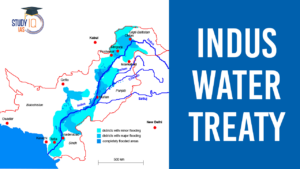Table of Contents
The discourse surrounding India’s relations with Pakistan often overshadows critical developments in the region, particularly concerning the Durand Line, which separates Pakistan and Afghanistan. This border has significant implications for regional stability and the dynamics of various movements within Pakistan.
| The Durand Line |
|
Key Geopolitical Shifts Impacting the Region
- The Iranian Revolution (1979): The rise of the Islamic Republic of Iran continues to fuel tensions between Iran and its neighbours and Tehran’s confrontation with the West.
- The situation is so volatile that experts fear it could lead to a broader conflict, possibly triggering World War III.
- The Soviet Invasion of Afghanistan (1979): The Soviet invasion was aimed at protecting a revolutionary regime in Kabul.
- The subsequent jihad against it, organised by the US and its regional allies, including Pakistan, succeeded in expelling Soviet forces by the late 1980s.
- The aftermath normalised Islamic militancy in South Asia and Pakistan, which supported the jihad but was later consumed by the rise of radicalism under General Zia-ul-Haq’s Islamization policies.
Recent Developments in Pakistan-Afghanistan Relations
- The recent Pashtun Qaumi Jirga held in Jamrud, Khyber district, highlighted significant grievances among the Pashtun population regarding their treatment by both the Pakistani state and militant groups.
- The Jirga concluded with 22 demands, including:
- Withdrawal of the Pakistan Army and militants from Pashtun lands.
- Accountability for enforced disappearances of activists.
- Fair distribution of natural resource benefits to local communities.
- Restoration of visa-free trade and travel across the Durand Line.
- These demands reflect a broader call for autonomy and recognition of Pashtun identity, which has been historically marginalised.
The Impact of the Taliban’s Return
- The resurgence of the Taliban in Afghanistan has shifted dynamics along the Durand Line.
- The Taliban’s assertion of autonomy contradicts Pakistan’s hopes of controlling Afghanistan through its influence.
- Additionally, accusations have arisen that Kabul is harbouring the Tehrik-e-Taliban Pakistan (TTP), which seeks to establish autonomous zones within Pakistan’s Pashtun regions.
- This situation exacerbates tensions between Islamabad and Kabul and complicates internal security for Pakistan.
Implications for Regional Stability
- Pakistani Military Response: The Pakistani military has historically responded to Pashtun nationalism with force. However, decades of societal upheaval have created deep-rooted grievances that cannot be easily suppressed.
- Baloch Nationalism: Concurrently, unrest in Balochistan is rising, with increasing violence against Chinese nationals and Punjabi settlers.
- This unrest feeds into broader sentiments of nationalism among both Pashtuns and Baloch people, threatening Pakistan’s territorial integrity.
- Geopolitical Consequences: The instability along Pakistan’s western frontiers poses risks not only for domestic governance but also for regional security dynamics involving India and other neighbouring countries.
The Broader Context of India-Pakistan Relations
- Despite occasional diplomatic engagements—such as External Affairs Minister Subrahmanyam Jaishankar’s recent visit to Islamabad, which was the first by an Indian foreign minister in a decade—the structural issues in India-Pakistan relations remain largely unchanged.
- Both nations exhibit a cycle of heightened expectations followed by disappointment, as significant breakthroughs continue to elude them.
Historical Paradox
- The relationship between India and Pakistan has been characterised by a paradox: while both countries occupy significant mental space in each other’s narratives, real diplomatic outcomes often fall short of expectations.
- This stagnation means that developments along the Durand Line may ultimately hold more relevance for India than immediate bilateral talks with Pakistan.
Conclusion
The complexities surrounding the Durand Line and its implications for Pashtun identity and nationalism are critical for understanding regional geopolitics. As tensions rise within Pakistan due to internal strife among ethnic groups like the Pashtuns and Baloch people, these developments could have far-reaching consequences for India-Pakistan relations. The lessons drawn from these dynamics may well influence future interactions across the Radcliffe Line, underscoring the need for a nuanced understanding of South Asian geopolitics beyond bilateral engagements alone.


 Indus Water Treaty 1960 Suspended by Ind...
Indus Water Treaty 1960 Suspended by Ind...
 5 Years of SVAMITVA Scheme and Its Benef...
5 Years of SVAMITVA Scheme and Its Benef...
 Global Pandemic Treaty, Objectives and K...
Global Pandemic Treaty, Objectives and K...





















